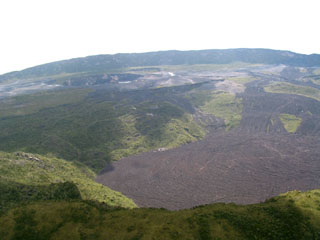Report on Nyamulagira (DR Congo) — 25 September-1 October 2024
Smithsonian Institution / US Geological Survey
Weekly Volcanic Activity Report, 25 September-1 October 2024
Managing Editor: Sally Sennert.
Please cite this report as:
Global Volcanism Program, 2024. Report on Nyamulagira (DR Congo) (Sennert, S, ed.). Weekly Volcanic Activity Report, 25 September-1 October 2024. Smithsonian Institution and US Geological Survey.
Nyamulagira
DR Congo
1.408°S, 29.2°E; summit elev. 3058 m
All times are local (unless otherwise noted)
A 28 September satellite image showed some minor advancement (around 200 m) of the W branch of Nyamuragira’s NNW lava flow compared to an 18 September image. Small thermal anomalies were concentrated near the end of the NNW lava flow and at the end of the W branch, and a few were located along the flow about of a third of the way up the flank. A thermal anomaly was present the part of the eastern crater floor. A few small thermal anomalies on the W flank flow were visible, though weather clouds obscured most of W flank. Weather clouds also obscured part of the summit crater and the upper NNW flow.
Geological Summary. Africa's most active volcano, Nyamulagira (also known as Nyamuragira), is a massive high-potassium basaltic shield about 25 km N of Lake Kivu and 13 km NNW of the steep-sided Nyiragongo volcano. The summit is truncated by a small 2 x 2.3 km caldera that has walls up to about 100 m high. Documented eruptions have occurred within the summit caldera, as well as from the numerous flank fissures and cinder cones. A lava lake in the summit crater, active since at least 1921, drained in 1938, at the time of a major flank eruption. Recent lava flows extend down the flanks more than 30 km from the summit as far as Lake Kivu; extensive lava flows from this volcano have covered 1,500 km2 of the western branch of the East African Rift.
Source: Copernicus

